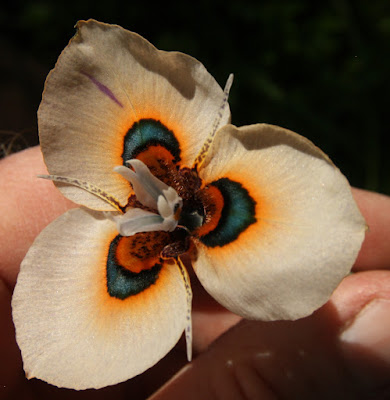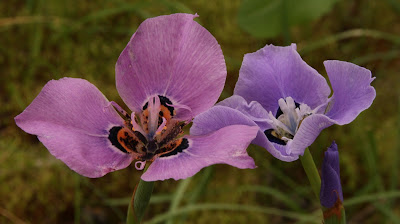(Click on the links to see more info on these flowers and photos of their parents and siblings.)
Flowers with stripes. Several new flowers had extravagant stripes on them. Most of these hybrids had M. tripetala in their background. That species is not striped in the plants I grow, but it appears to induce stripes in many hybrids.
MM 13-133a (tripetala x villosa)
MM 13-136a (tripetala x villosa-tulbaghensis hybrid)
MM 13-171a (tripetala x villosa)
Flowers with rings. Just as M. tripetala tends to produce striped hybrids, it's turning out that M. bellendenii often produces rings on the outer tepals, even though they are not present in the species.
MM 13-139 (bellendenii x a complex hybrid that has pink flowers)
MM 12-158c (bellendenii x a yellow hybrid)
MM 13-125b (aristata-villosa hybrid x bellendenii). The first time I've gotten orange in the eye color for a Moraea hybrid. Very curious.
MM 12-118c (villosa x bellendenii). This cross produced a number of interesting flowers; click through to see more.
Given the results above, you'd think a hybrid of M. tripetala and M. bellendenii would be incredible – stripes and rings! Alas, it's just a plain pale yellow flower. MM 13-196a
Pastels and color blends. Moraea flowers generally have bright colors that are uniform across the tepals, but this year I got a number of hybrids that were washed with pastel color blends.
MM 12-44a (villosa x a yellow hybrid)
MM 13-10a (aristata - villosa hybrid x neopavonia)
MM 13-34a (atropunctata-calcicola x neopavonia) Another cross that made a series of interesting flowers.
MM 13-34c (atropunctata-calcicola x neopavonia)
MM 13-58a (atropunctata-neopavonia hybrid x villosa)
MM 13-13a (pale orange gigandra hybrid x villosa)
MM 12-151a (neopavonia-villosa hybrid x villosa)
MM 13-149c (pale cream gigandra hybrid x villosa-tulbaghensis hybrid) Every flower from this complex cross looks very different.
MM 12-111a (tripetala x aristata)
Beautiful color combinations. These were two of my favorites for the year. The first one is a soft peach color, with a big and very brilliant blue eye. The second one is much rosier-colored than the typical purple Moraea.
MM 12-155a (Zoe x neopavonia)
MM 13-120a (left) (pale yellow gigandra hybrid x tripetala)
Moving toward red, sort of. I'm continuing to try to breed red Moraea flowers, without a breakthrough. But I'm getting some nice rosy pink ones.
MM 13-45a (atropunctata-calcicola hybrid x villosa)
MM 12-151b (neopavonia-villosa hybrid x villosa)
At last, hybrids with M. lurida. Moraea lurida is one of the stranger-looking Moraea flowers, often with complex markings in dark maroon and pale yellow. I was deeply curious to learn how it would combine with other species, but it self-pollinates easily, so I had a lot of trouble getting hybrids. This year I finally succeeded, and the hybrids were weird and wonderful.
MM 12-194 (lurida x tripetala)
MM 12-193b (lurida x villosa) Another flower with a strange orange eye.
MM 13-195a (lurida x aristata-villosa hybrid) This one has a little yellow eye.
MM 13-197a (lurida x villosa) Check out all those stripes and veins.
Pale blue eyes. Peacock Moraea flowers are named for the big eye-spots on the flowers, in shades of dark blue, turquoise, and green. A couple of new hybrids this year had very pale blue eyes, a color that jumps out at you when you see it in person.
MM 12-64a (a cross of two white-tepaled villosa forms)
MM 12-118e (villosa x bellendenii)
Even more dots. Last year two of my favorite hybrids were plants I named "Crazy Dots" and "Psycho Dots" because they had so many spots on them. This year two new siblings of those plants bloomed. The first is a big robust flower with huge dots, and the second has the most dots of any hybrid I've raised.
MM 12-139 c and d (Zoe x atropunctata)
Star streaks. I love the precise little star streaks radiating from the center of this flower.
MM 12-141c (tripetala x aristata)
Honorable mention...
These flowers weren't as spectacular as the ones above, but I think they deserve mention.
Dark purples. I tried crossing some purple species of Moraea, and the results are rich inky purple, often with black centers. They lose some of the inkiness when photographed, but look great in person.
MM 13-177d (gigandra x calcicola)
MM 12-49b (loubseri x gigandra)
MM 12-120a (gigandra x villosa)
Weird colors and shapes due to M. loubseri. One of the strangest Moraea flowers is M. loubseri, a purple flower with a hairy black center. These hybrids of it are even weirder: very hairy but with shades of green and burnt orange beneath the black hairs.
MM 13-84c (loubseri x a complex orange hybrid)
MM 13-85a (atropunctata-neopavonia hybrid x loubseri)
MM 12-13a (loubseri x atropunctata)
Another orange gigandra. Last year one of my favorite hybrids was a cross of M. neopavonia and M. gigandra, which produced some nice large flowers in shades of mauve and orange. This year an even more brightly colored sibling bloomed for the first time.
MM 12-144c (gigandra x neopavonia)
Nice contrast. A dark orange center and pale orange tepals. Elegant.
MM 14-134a (Zoe x a complex orange-brown hybrid)
Interesting spots and streaks.
MM 13-192a (atropunctata-calcicola hybrid x longiaristata?)
MM 12-149c (longiaristata? x aristata)
MM 14-187c (villosa x atropunctata)
The strange combination of purple and yellow. When you're a kid playing with fingerpaint, you learn that combining yellow and purple produces a nasty shade of brown. The effect is not quite the same in flowers, but this hybrid of purple and yellow flowers is clearly having trouble deciding what color it wants to be.
MM 12-109b (gigandra x a yellow hybrid)
Nice species hybrid. Combining bright pink M. tricolor and pale blue M. ciliata produces this little magenta beauty. Alas, it's totally sterile.
MM 12-15a. (tricolor x ciliata)
Want to see more? All of the new crosses from this year are listed in this blog. If you're browsing on a computer, you can use the Blog Archive at right to access them. They were all posted in June and July of 2017, one post per cross.
What I'm learning...
I welcome comments and advice on any of this.
Two more Moraea species can interbreed. I have added M. lurida and M. debilis to the list of plants that will interbreed with the peacock Moraeas. I'm also continuing to try with M. polystachya, polyanthos, fergusoniae, and unguiculata, so far with no confirmed success. The full details on species compatibility are here.
Pollination success is declining. For the second straight year, I noticed that fewer of my crosses successfully produced seeds, and the pods I did get were often small. I'm probably now getting seeds from at most one cross in four. I ended up with only about 100 seed pods this year, compared to more than 200 in previous years with a smaller base of plants. I can think of three explanations:
-I'm now making many more crosses with second- and third-generation hybrids, which have more complex genetics. Maybe that's reducing fertility.
-I have changed the way I store pollen (switching from film canisters to glassine envelopes). Maybe that damages the pollen.
-Maybe last winter's heavy rain washed the pollen out of many flowers.
A friend who also experiments with Moraeas, Garry Knipe, has reported the same decline in fertility over a couple of years, so I suspect the main cause is genetic complexity. Bummer.
No luck with imported pollen. I obtained some Moraea pollen from South Africa last fall. Unfortunately, none of it produced seeds here. Darn.
I don't know if the problem was the couple of weeks it spent in transit, or the six months in the freezer, or something else. In the past I've set seeds with home-grown pollen stored in the freezer for a year, so the problem wasn't only the freezing.
Raised beds continue to work well. Flower numbers and leaf growth continue to be far better in my raised beds than they are in pots. I believe (but can't prove) that's due to a couple of factors:
-The moisture and temperature are more constant in a raised bed. Leaf dieback is rare and limited on Moraea plants raised in the beds. In pots at my house, it's common for Moraea leaves to die back halfway or more during the growing season.
-I can exclude most weeds and insects from the raised beds (they're surrounded by window screening). So there is less competition for the plants in beds. You can see more info on the beds here.
I've started raising seeds directly in the beds. In the past I had raised seeds in plastic drinking cups, transferring them after two years to pots or beds. But that transfer process takes a lot of time, because some of the baby bulbs are very small and have to be sieved from the soil. So I've now started planting the seeds directly in beds. That makes me nervous because heavy rains can churn the soil in a bed much more than they do in seed cups, but the tiny seedlings appeared to tolerate it. I'll need several more years to judge the success of this approach.
The jury is still out on my plunge bed. Last summer I built a plunge bed for about 80 pots, to see if that would reduce leaf dieback. It's hard to judge the success of that because last winter was incredibly rainy and cool and the plants in pots weren't stressed the way they usually are. What I did notice is that I had a huge amount of insect damage to plants in the plunge bed. Apparently slugs, snails, cutworms and the like find it easy to hide in the plunge material during the day and then crawl out to eat things at night. If the pots don't have plunge material around them, the commute up to the plants is much longer and there is less area to hide in.
I'll keep experimenting.
Looking for seed and pollen. I'm continuing to seek seeds (and pollen) of a number of Moraea species. I'll gladly pay or trade. The list is here.
I am glad to share seeds (and corms, if I have extras) from my collection. There is no charge, but I will ask you to make a voluntary contribution to the Pacific Bulb Society so I don't compete with its seed and bulb exchange. Let me know if you're interested. My contact info is at the bottom of the post here.


















































